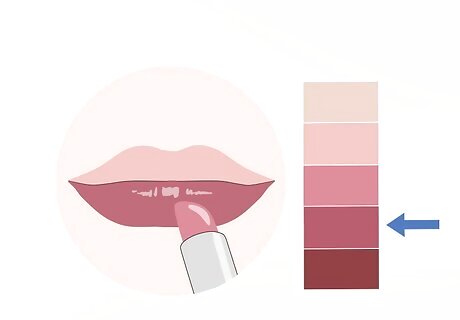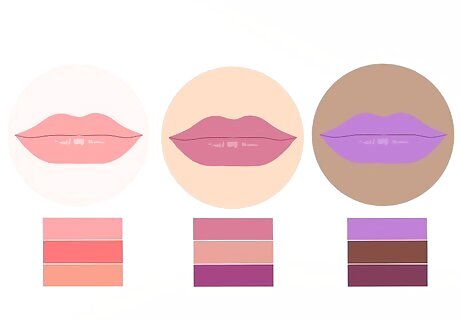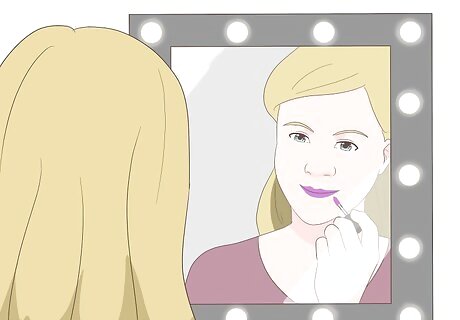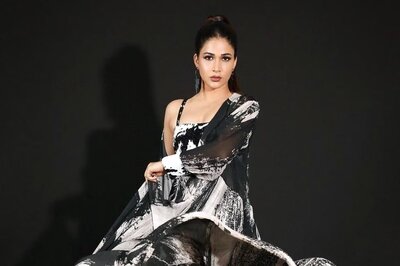
views
Determining your Skin Tone
Examine your skin in natural lighting to determine your complexion: fair, light, medium, tan, deep. Concentrate on the skin around your jaw line. Fair skin: your skin is very pale or translucent and you burn very easily. You may have freckles and some redness. Light skin: your skin is pale. When you are in the sun, you burn and then may possibly tan. Medium: you tan easily and generally don't burn or have sensitive skin. Tan: your skin is tan or olive. You rarely burn and look tanned even in the winter. Deep: your skin is dark and you never get sunburned. Your hair is possibly black or dark brown.

Look at the color of the veins on the inside of your wrist. This is a quick way to figure out if you have a warm, neutral, or cool skin tone. Blue or purple veins indicate you have a cool skin tone. Green veins mean you have a warm skin tone. If you have difficulty deciding if your veins are blue or green, you likely have a neutral skin tone and can choose colors from both the cool and warm spectrum. People with olive skin usually have neutral undertones.
Notice how your skin reacts to the sun: do you tan or burn easily? Skin that tans easily has more melanin indicates a warm skin tone. Most people of African, Caribbean, and Indian descent fall into this category. If you burn before you tan (and maybe can't tan at all), then your skin has less melanin and you have a blue skin tone. If you have deep ebony skin, you may actually fall into this category.
Try on gold and silver jewelry. Which looks better? Gold jewelry looks best with warm skin tones. Silver jewelry looks best on cool skin tones. Both look good on a more neutral skin tone. This can be a good "tie breaker" if you don't clearly meet the criteria listed already.
Choosing an Everyday Color

Find a color that is one to two shades deeper than your natural lip color. To test how close the shade is to your natural color, apply the lipstick only to your lower lip. Compare that shade to the your upper lip. If the shades are drastically different, you need to keep looking. EXPERT TIP Katya Gudaeva Katya Gudaeva Professional Makeup Artist Katya Gudaeva is a Professional Makeup Artist and the Founder of Bridal Beauty Agency based in Seattle, Washington. She has worked in the beauty industry for over 10 years and worked with companies such as Patagonia, Tommy Bahama, and Barneys New York and with clients such as Amy Schumer, Macklemore, and Train. Katya Gudaeva Katya Gudaeva Professional Makeup Artist Consider the shade of your teeth when choosing lipstick. Professional makeup artist Katya Gudaeva says: "One thing to keep in mind is that cooler tones of red lipstick will make your teeth appear whiter. If your teeth aren't as white as you'd like, you probably should avoid orange lipstick, as they'll make your teeth look more orange."
Decide if you want your lips to look smaller or larger. Dark shades will actually make your lips look smaller, while lighter shades can add plumpness. Lipstick with a matte finish can also cause lips to look thinner, while glosses and shimmery shades can make them look fuller.
Determine your undertone and complexion. Remember that your undertone and complexion will help guide you, but they aren't the be-all-end-all of choosing a lipstick color. It is important to try on different shades and, ultimately, choose what you feel looks best.

Experiment with shades that experts recommend for your complexion and skin tone. If you have fair or light skin, try light pink, coral, peach, nudes, or beige. If you have cool undertones, try a soft mocha and nude. Warm undertones, try pale pinks or a nude with a little peach. If you have medium skin, try rose, mauve, or berry shades. Cool undertones: try shades of pink or cranberry. Warm undertones: experiment with copper or bronze. If you have tan skin, try to avoid browns and purples and go for colors with an orange undertone. Most other colors will look great. Try coral, or deep pink. If you have a deep complexion, try browns or purples like walnut, caramel, plum, or wine. Cool undertones should look for ruby and wine-colored reds. Warm undertones: try copper or bronze.
Keep it subtle. Unless you're feeling like making a statement with bold lips (which is totally fine!), apply strong shades to your lower lip only. Press your lips together, then use your finger to even out the color.
Choosing the Right Red
Find the right color for your skin tone. Again, use your skin tone and complexion as a guide--if you find a color you love that breaks the "rules"--go for it! Fair or light skin should look for dusty, pinkish red or coral. Cool undertones: raspberry. Warm tones: try reds with a blue undertone or coral. Tan or medium skin should look for bright red cherry red, or true red with no undertone (if you have a neutral undertone). Warm undertones: orangey-red or tangerine. Cool undertones: wine. Deep skin with warm undertones should try blue-based red. Cool: Metallic ruby red or deep wine.
Wear red with pride. This is a classic look that anyone can pull off, regardless of age, skin, hair, eye, or lip color. Own it!
How to Shop for Lipstick
Try the lipstick on before you buy it. Clean the tester with a little alcohol (the store should provide this in a spray bottle) and use a test brush or a cotton swab to apply the color to your lips. If you don't want to apply the tester lipstick to your mouth, test it on the pads of your fingertips. Your fingertips are closer to your lip color than your wrist or the side of your hand.
Remove one lip color completely before trying on the next. Otherwise, you will be mixing multiple colors together. Ask a sales rep for makeup remover or lotion.

Make sure you are in a well-lit area.
Try on lipstick with little or no other makeup on your face. Look for a shade that, worn with no other make up, brightens your face and makes other makeup unnecessary.
Ask for help at the makeup counter. Sometimes it's hard to objectively judge what looks best on ourselves. A professional at the makeup counter can match you with the right color.
Matching a Lip Color with the Rest of Your Look
Don’t match a lip color too closely with your clothing. For example, if you are wearing a fire-engine red dress, wearing the same exact color on your lips will look overwhelming.
Have fun and experiment, but consider these guidelines if you're not sure: Nude lips look great with just about anything. It's a great casual look and can help play up dramatic eyes. Red can add drama to a fairly plain outfit. Try not to overwhelm by wearing red with very bright clothing or clothes with crazy patterns. Pink is versatile because there are so many shades. Pinks that are just a few shades brighter than your natural lip color work for a subtle, everyday look. Berries can make a dark ensemble seem sombre and can weigh down an airy, summery look. Try matching berries with mixed neutrals.
Go for dramatic lips or eyes; not both. Stick to just mascara on the eyes, or just a bit of dark brown eyeliner in between your lashes.



















Comments
0 comment